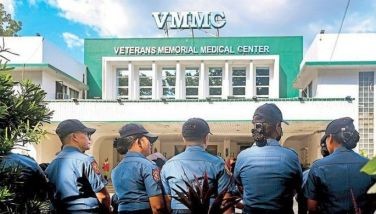The Ladies and the Knights of Rizal, Bonn chapter
HEIDELBERG, Germany — Spring is very much in the air here. The two-week Easter holiday break has brought throngs of tourists from all over the world to Heidelberg, the university town which our national hero, Dr. Jose Rizal, loved.
The Renaissance ambience with quaint Medieval Age houses lined up narrow streets with cobbled stones. (Walking flat shoes are necessary.)
Sir Peter Paul Plueckebaum, Chapter Commander of the Bonn Chapter of the Knights of Rizal, went out of his way to drive me here, two hours away from Bonn, together with his wife, Lady Jenny, the president of the Ladies for Rizal (Kababaihang Rizalista) — a separate socio-civic organization. Her vice president, Susan, came along with her German husband, Toni Wallenweber, the director of the National Gallery of Modern Art in Bonn.
A Las Flores (las Turistas) de Heidelberg
Busloads of tourists filled the grounds of the castle of Heidelberg high up on the hill overlooking the city and the Neckar River that cuts through the town. The pink camellia trees, yellow daffodils and the fragrant honey suckle reminded us of Jose Rizal’s poem, A Las Flores de Heidelberg.
Downtown, we walked through a popular public place with a walking street for tourists. It is the University of Heidelberg area where a handsome huge red Bibliotheque building complex stands out. Alongside is a block of buildings with bookstores, student mess halls, and gift shops for students.
Rizal lived on the top floor of the Zihanke Bookstore. It was then a typical pension house (boarding house) for students. A Mexican student was impressed to read the German commemorative plaque stating that the Philippine national hero, Dr. Jose Rizal stayed here.
By the fountain in the middle of the square is the museum of Heidelberg. More Renaissance type buildings of the university were across the plaza. Past this is a narrow walking street lined with small cafes and bistros where students gather. A quick lunch at Rock Café brought us back to the 21st century.
Propagating the ideals and teachings of Rizal
According to Lady Amelia Abitong-Huetwohl (Ladies for Rizal, Bonn president 2004-2005), it was then Philippine Ambassador Gregorio Abad who organized the European Knights of Rizal with his embassy staff as members. One of them was the staunch Rizalista, Sir Celso Lacuna. Some of the early members were the Amargas, Bruers, Sittigs, Klingerts, Gomezes, Sta. Marias, Van Opstals, and Kropps.
The European Chapter became inactive until Sir Celso Lacuna had it registered in 2002 as an official organization. Unanimously elected as Knights of Rizal Commander Bonn Chapter was and still is – Sir Peter Plueckebaum. His wife, a Filipina nurse from Bohol, Jenny became the president of the Ladies for Rizal.
I noted that the German husbands of these Ladies are remarkably fervent followers of Dr. Rizal. Most of the ladies are Filipino nurses who have arrived in Bonn between the ’70s to the ’90s.
Rizalism in the new millennium
Let me quote from the excellent eight-page article of Sir Peter, “Rizalism in the New Millennium”, which he wrote last year in the booklet, “Rizal Today.”
Dr. Jose Rizal lived only for 35 years. Born on June 19, 1861 of upper middle class family in Calamba, Laguna, he did his earlier studies in the Philippines finishing his high school in Ateneo at Intramuros. At 21, he left for Europe to study ophthalmology. Due to his intense desire to cure his mother, he studied medicine in Madrid for the first three years and did his specialization with French ophthalmologist Prof. de Wecker in Paris and Prof. Becker at the University of Heidelberg Eye Clinic in 1886.
Mr. Plueckebaum reminds: “We have to consider the social and cultural changes, as well as the political revolution of the past century. On Rizal’s seventh year in Europe – 1889 – France celebrated the 100th anniversary of the French Revolution. After this, two world wars have changed the social structures in most part of the world.”
Rizal’s legacy must not be limited to being a mere historical figure
The pledge of the Knights of and Ladies for Rizal remains: “We, the Knights of Rizal and Ladies for Rizal have pledged to foster, emulate and maintain the legacy of Rizal… and not limit him to being a mere historical figure… We are obliged to approach the ethical, political and social aspects in the person of Rizal…”
On one of his annual visits to Bohol, Sir Peter asked a high school student what he thought of Jose Rizal. The student replied as he would to his teacher – “Jose Rizal is our national hero. He died so Filipinos could gain freedom.”
“Is that all?” Sir Peter reflected. “Is that all what remains of Dr. Jose Rizal – a mere data in history and consciousness of the young Filipinos?”
14 years in ‘Enlightened’ Europe
Although it is difficult to define Rizalism, some principles are recognizable. Herewith are Sir Peter’s reflections:
“Rizal’s journeys all over Europe were eye-openers to him. ‘To travel is a desire innate in man as the love of knowledge.’ The constraints on education and freedom caused by the Spanish colonizers and the restrictions in education imposed by the Catholic Church were the mental barriers Rizal overcame due to so much he learned traveling and meeting important academic and political people.”
As an early “globetrotter”, Rizal was all over Europe for 14 years (1882-1896) from the age of 21. Writing to his family in 1886, he said: “I am here in Germany going from town to town, visiting education centers, town schools, parishes, Catholic and Protestant services, and sanctum synagogues of the Jews. Everything that can teach me, interest me, so I can bring to the Philippines the best that I find here… Travel makes the whole world one.”
He learned Spanish, German, Italian and French. For Rizal: “Languages will open to you the treasures of a country.” Filipinos must come to Europe to discover liberty and dignity of one’s race.
In his novel, Noli Me Tangere, Rizal was personified by Ibarra who stated: “My father wants me to go abroad… to learn the science of life in an atmosphere without prejudices.”
‘Losing his heart’ to Heidelberg
Sir Peter thinks that to romanticize Dr. Rizal as a lover is belittling his true significance to the nation. Sir Peter drove us 30 minutes away to Wilhemsfeld, Rizal’s home next to Heidelberg to meet Rizal scholar Rainer J. Weber. A retired teacher of English, History, Social and Political Studies, Sir Weber is the KR Commander of Wilhemsfeld.
We met in the shrine of Rizal, which was built with funds from Filipino nurses working in Germany. It is on a hill overlooking the other green hills and woods Rizal loved to walk around. His handsome bust by sculptor Caedo is surrounded by smaller busts of his close friends, Pastor Karl Ulmer, Prof. Otto Becker, Rudolf Virchow, and Prof. Ferdinand Blumentritt.
Then, we drove five minutes away to a lovely village church. His father, Pastor Gottlob Weber, the Protestant Vicar lived in the same house (Sir Rainer pointed to a two-storey house by the church) where Rizal stayed with the loving family of Pastor Karl Ulmer “for a few happy months in 1886”.
Pastor Weber, for 25 years, was the most ardent and committed expert on Rizal in Germany. As guest speaker in the Rizal Centenary Congress in Manila in 1961, he was called “Germany’s Number 1 Rizalist.”
Carrying two leather-bound albums filled with press releases of his father and many Filipino and German dignitaries who been visiting the shrine, Sir Rainer pointed to several photos of Mrs. Mendez, wife of Ambassador Lauro Mendez (and my dean in the graduate school of Centro Escolar University) to whom he attributed the work of putting up commemorative plaques of Dr. Rizal in Germany.
Heidelberg, an inspiration to Rizal
The calmness and solitude of the pastoral village; the long conversations with Pastor Ulmer and Fr. Herman Bardorf, a Catholic priest so inspired Rizal that this was where he perfected Noli Me Tangere.
To Blumentritt, Rizal wrote from Dapitan, “how much I wish to breathe the perfume of the pines of Wilhelmsfeld. One walks thru the forest, gathers strawberries and at the nearest tavern one orders Rhine wine…”
(Next week: Rizal is Alive)
(For more information or reaction, please e-mail at [email protected] or [email protected])
- Latest





























